Обеспечение антикоррозионной защиты и поддержание её высоких эксплуатационных характеристик являются одними из наиболее важных факторов, гарантирующих надёжность и длительный срок службы трубопровода. Комплексная программа мероприятий по антикоррозионной защите осуществляется на всех этапах — как производства труб, так и строительства и эксплуатации трубопроводов.
Waterproofing (from other Greek Υδωρ - water and insulation) - protection of building structures, buildings and structures from the penetration of water (anti-filtration waterproofing) or the material of structures from the harmful effects of washing or filtering water or other aggressive liquid (anti-corrosion waterproofing). Waterproofing works are called waterproofing works. Waterproofing ensures the normal operation of buildings, structures and equipment, increases their reliability and durability.
Теlephon, Viber, WhatsApp, Telegram: +38 050 617-64-77, e-mail: 7853221@gmail.comТеlephon:+38 067 857-26-62, +38 099 905-98-60, +38 098 704-59-17, +38 098 972-98-00
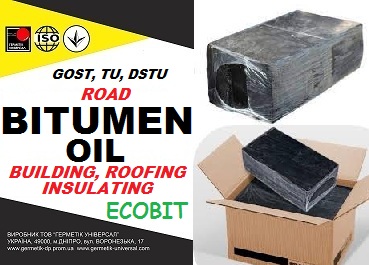
Bitumen has long been one of the most famous and important building materials. Due to its adhesive and hydrophobic properties, it is widely used in road construction, the manufacture of roofing materials, the construction of foundations for buildings and structures, and the laying of pipelines.
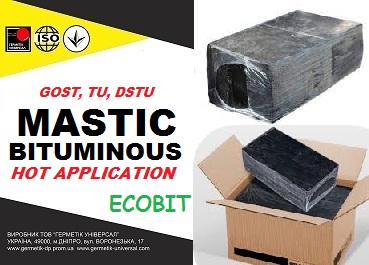
Ecobit hot bituminous mastic is intended for the installation of rolled waterproofing coatings, as well as mastic, reinforced with glass materials. This homogeneous mass, consisting of a bituminous binder and filler, is used in a hot state, it can be made with additives of antiseptics and herbicides.
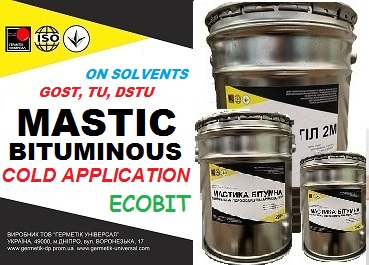
One-component bitumen mastics, one-component bitumen-polymer emulsions and one-component polymer-bitumen waterproofing materials are used for waterproofing surfaces in direct contact with the ground, from ground moisture and from accumulating seepage moisture, foundation waterproofing, basement waterproofing, house waterproofing.
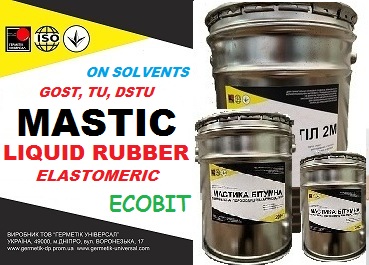
Mastic - elastomeric, its main part and vulcanizing paste are mixed immediately before application, the viscosity of the mastic is adjusted by adding a solvent for waterproofing surfaces in direct contact with the ground, from ground moisture and from accumulating seepage moisture, foundation waterproofing, basement waterproofing, house waterproofing.
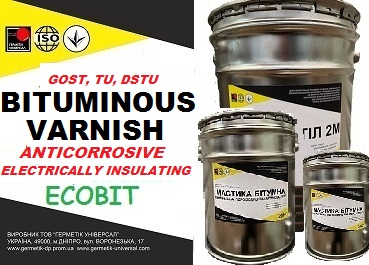
Ecobit bituminous varnishes are a black or dark brown liquid of medium viscosity with a characteristic oily smell. Pre-drying time 1.5-2 hours, complete drying - up to 24 hours. When dry or too thick, it can be diluted with mineral spirits or any other volatile hydrocarbon non-polar solvent.
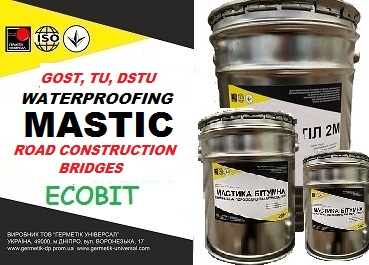
Road mastics. Road construction (road construction) is a branch of construction involved in the design, construction, repair and maintenance of roads (highways), access roads and city streets. This concept, as a rule, includes the management, organization of work and supervision of the condition of roads
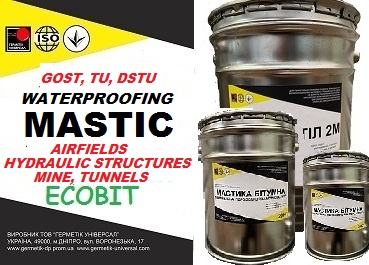
Mastics for airfields. An aerodrome is a complex of engineering structures that includes the airfield itself (runways, taxiways, operational aircraft maintenance stands), facilities of the air traffic control complex (air traffic control tower, airfield meteorological service, production sites, workshops, hangars, technical and storage rooms
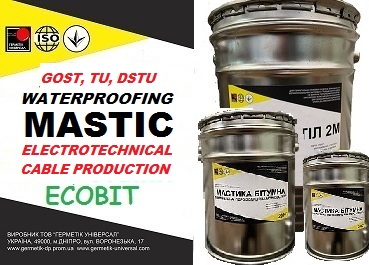
Mastics for cables. The ingress of moisture into the cable harms both electrical (due to a decrease in insulation resistance, up to breakdown, corrosion of conductive cores) and optical (due to clouding of the optical fiber) cables. To protect communication cables from moisture, a hydrophobic filler is used, as well as compressor-signal installations that supply
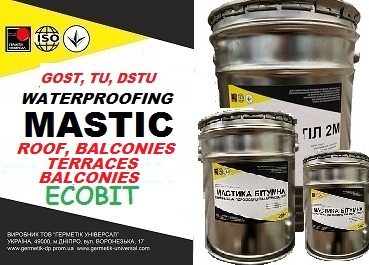
Roof mastics. A roof is the top protective element of a building that is exposed to atmospheric influences. Its main function is to protect the interior from atmospheric precipitation and influences. The main requirements for the roof are lightness
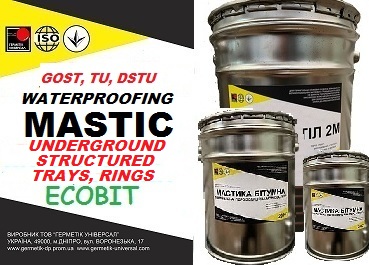
Mastics for underground structures. Underground industrial structures - structures (objects) of industrial, agricultural, cultural, defense, municipal and other purposes, created under the earth\'s surface. Subways, railway, automobile tunnels.
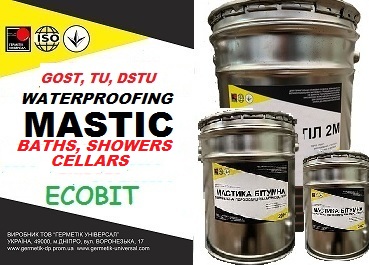
Basement mastics. Basement - the floor of a building with a floor level below ground level by more than half the height of the premises or the first underground floor. Serves to accommodate various equipment, supplies. It is characterized by the stability of daily and annual temperatures due to the heat-insulating properties of the earth and the absence of natural sunlight.
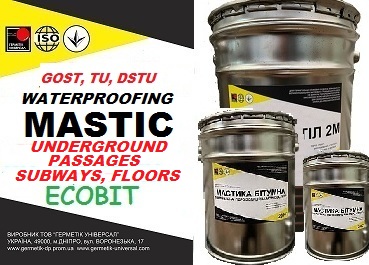
Mastics for underground structures. An underground pedestrian crossing is a public road structure, consisting of a tunnel under a roadway, railway or river. Subway, metro - an urban off-street railway, having its own dimensions, engineered separated from any other transport and pedestrian traffic and intended for passenger traffic. It can be underground, aboveground and aboveground.
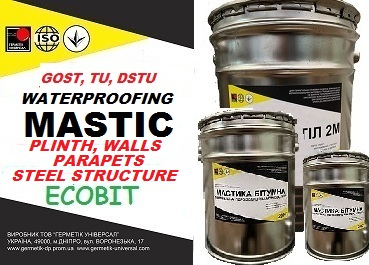
Mastics for metal and cars are most suitable for bitumen-polymer and rubber-bitumen mastics. It perfectly protects the car, but before processing, the metal must be cleaned of dirt and rust, washed and dried. Great adhesive ability allows the use of mastics for the treatment of different surfaces. Here, not only concrete and wooden structures, pipelines for various purposes, metal structures .
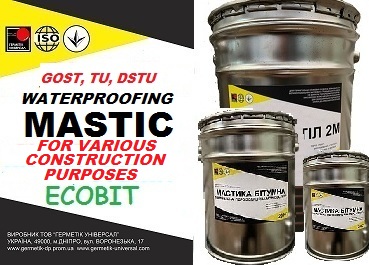
Mastic for construction is a very plastic material. It has high astringent and waterproofing properties. In the main composition of the material, in addition to bitumen, there are astringent organic substances and mineral additives. Bituminous mastics have a huge area of use. Most often, bitumen-based materials are used to perform various jobs.
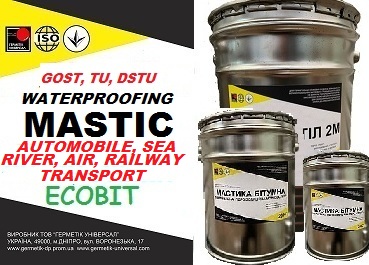
Mastics for transport. For metal and cars, bitumen-polymer and rubber-bitumen mastics are most suitable. It perfectly protects the car, but before processing, the metal must be cleaned of dirt and rust, washed and dried. Mastic bituminous rubber is an excellent protection against decay and corrosion.
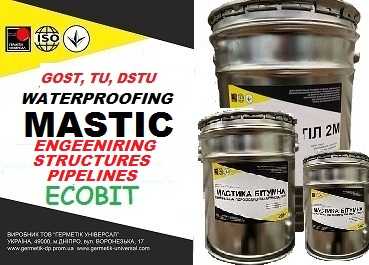
Mastics for pipelines. Great adhesive ability allows the use of mastics for the treatment of different surfaces. Here, not only concrete and wooden structures, pipelines for various purposes, metal structures can be added to the list. Insulation of steel pipelines for gas and water.
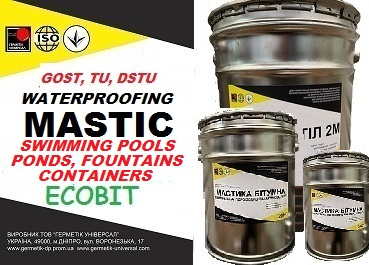
Mastics for pools, ponds. To seal the pool, thiokols and rubber-bitumen mastics are most often used. Mastics harden right in the seam and eventually turn into an elastic black sealant. To fill the seams use a pneumatic syringe with replaceable cartridges.
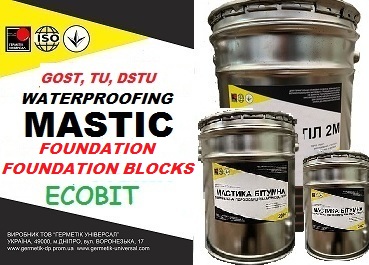
Mastics for foundations. For waterproofing the foundation. The coating is done both on a strip foundation and on a pile foundation. For all types of waterproofing, one cannot do without mastic made from petroleum bitumen, to which organic and mineral solvents and fillers
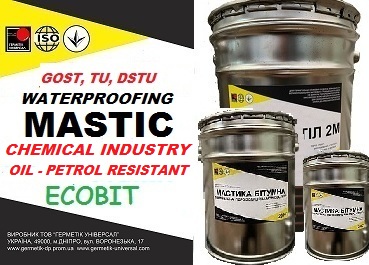
Mastics are chemical resistant. The high chemical resistance of fillers allows the use of mastics for the treatment of various surfaces. Here, not only concrete and wooden structures, pipelines for various purposes, metal structures can be added to the list. Protection against the action of acids, alkalis, gases. Protection: sulfuric acid, hydrochloric acid, nitric acid, ammonia. Gumming of technical tanks, equipment, collectors, sewer systems
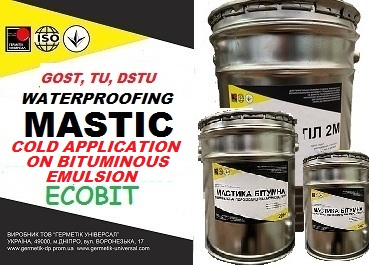
Mastics on bituminous emulsions Ecobit. They are made on a water basis - which characterizes the material as not harmful to the environment. The coating does not have a pungent odor, dries in a couple of hours. Water-based waterproofing cannot be used at low temperatures. It is also worth storing the material in a warm room. Waterproofing work must be carried out in dry, clear weather, at a temperature not lower than -5°C.
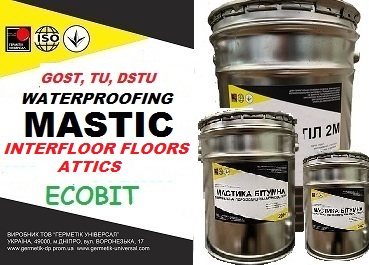
Mastics for attics, ceilings, sheds. Bituminous mastic for roofing can quickly and efficiently seal the surface, without the use of technology. Mastic can be applied to any cleaned and even roof surface. Floors treated with mastic have a long service life. If she still needs repairs, it will be very easy to repair the ceiling at any time of the year.
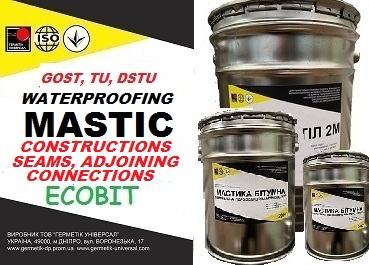
Mastics for sealing joints in concrete pavements can be used hot bituminous or cold mastics produced by the industry. They withstand more than 200 defrosting and freezing cycles. Bituminous mastic for bridge expansion joints. To repair asphalt and seal the roadway, special mastics are used. They withstand strong compression and stretching.
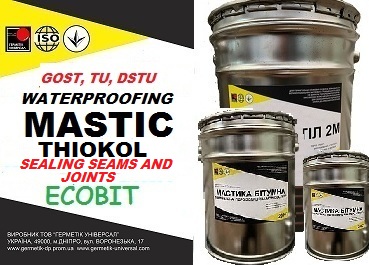
Thiokol mastics. Thiokol mastics are considered the best sealing materials, as they cure without shrinkage, providing complete sealing reliability. In addition, it is convenient to work with them: they are applied with a spatula, brush, syringe or simply by watering Thiokol mastics have good adhesion to many materials
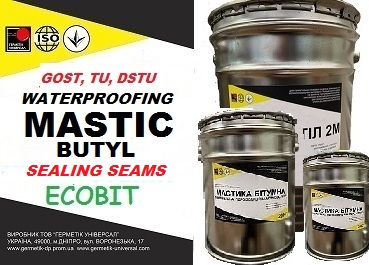
Butyl mastics is a high-viscosity homogeneous non-hardening mass, made on the basis of butyl rubber and styrene-butadiene rubber with the addition of fillers, plasticizers and adhesive additives. Application: used for sealing joints of structures of large-panel buildings.
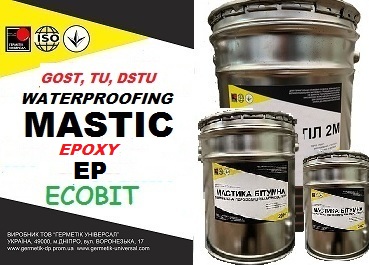
Epoxy mastics - putty, a mixture of different substances for gluing, cementing, filling cracks in order to make an object impervious to water. Hardening occurs due to the evaporation of the mastic solvent or a chemical reaction of mixed substances. For the preparation of mastic are used: chalk, lime, gypsum, sand, crushed glass, etc.
Waterproofing (from ancient Greek Υδωρ - water and insulation) - protection of building structures, buildings and structures from the penetration of water (anti-filtration waterproofing) or building materials from the harmful effects of washing or filtering water or other aggressive liquid (anti-corrosion waterproofing). Work on waterproofing is called waterproofing work. Waterproofing ensures normal operation of buildings, structures and equipment, increases their reliability and durability. Often used in conjunction with drainage.
Waterproofing materialsFor waterproofing, waterproofing materials are used, which include:
- dry building mixtures of penetrating action (penetrating waterproofing).
Types of waterproofing
Anti-filtration waterproofing is used to protect against water penetration into underground and underwater structures (basements and recessed rooms of buildings, transport tunnels, mines, sinkholes and caissons), through retaining hydraulic structures (dams, their screens, depressions, diaphragms), as well as for protection from leakage of operational and technical water or waste water (canals, tunnels and other water conduits, pools, settling basins, reservoirs, etc.).
Anti-corrosion waterproofing is intended to protect the material of structures from chemically aggressive liquids and waters (mineralized groundwater, sea water, wastewater from industrial enterprises), from the aggressive influence of the atmosphere (above-ground metal structures, hydraulic structures in an area of variable water levels) and from electrocorrosion caused by wandering water. currents (power line supports, pipelines and other underground metal structures). Based on the type of base material, anti-corrosion waterproofing is divided into asphalt, mineral, plastic and metal; according to the method of installation - painting, plastering, pasting, casting, impregnation, injection, filling, mounting; according to the main purpose and design features - surface, keyed, working “for pressing” and “for tearing”, sealing seams and interfaces, for complex purposes (thermal and waterproofing, plastic expansion joints).
Painted waterproofing (hot and cold) is carried out in the form of a thin (up to 2 mm) multilayer coating, usually from bitumen and polymer varnishes and paints, for anti-capillary and anti-corrosion protection of reinforced concrete and metal structures. The most reliable are hot bitumen-polymer and cold epoxy-rubber coatings. New cold-curing polymer materials are increasingly being used.
Plaster waterproofing (hot and cold) is a multi-layer (up to 2 cm) coating; The most common for reinforced concrete structures are: cement shotcrete, cold and hot asphalt plaster mortars and mastics, which do not require a protective fence and allow the process of their application to be mechanized. The use of polymer concrete and polymer cement coatings and colloidal cement mortar is expanding.
Pasted waterproofing is produced by gluing roll materials in the form of a multi-layer (usually 3-4 layers) coating with mandatory protection by surface screeds and walls. Despite its wide distribution, glued waterproofing is in some cases replaced by painting and plaster waterproofing. Characterized by increased crack resistance; its improvement is proceeding along the path of using polymer films and fiberglass.
Cast waterproofing is the most reliable type of waterproofing; It is usually made from hot asphalt mastics and mortars by pouring them over a horizontal base (in 2-3 layers with a total thickness of 20-25 mm) and pouring them behind the wall or formwork on the walls (30-50 mm thick); due to complexity and high cost, it is performed in especially critical cases. Its development follows the path of using asphalt expanded clay concrete, bitumen perlite, foam epoxides and other foam plastics.
Backfill waterproofing is carried out by pouring bulk waterproofing materials into waterproof layers and cavities, for example, fenced with formwork. It is similar in design and purpose to cast waterproofing, but has a greater thickness (up to 50 cm) and a complex thermal and waterproofing purpose (hydrophobic sands and powders, asphalt insulation) with low water resistance.
Injection waterproofing (injection) A method of repairing building structures by injecting injection material under pressure to fill cracks, voids and cavities in the structure, as well as the adjacent area behind the structure to restore its strength and tightness.
Impregnation waterproofing is carried out by impregnating building products made of porous materials (concrete slabs and blocks, asbestos-cement sheets and pipes, limestone and tuff blocks) in an organic binder (bitumen, coal tar pitch, petrolatum, polymer varnishes). Impregnation waterproofing is most reliable for prefabricated elements exposed to intense mechanical stress (piles, pipes, tubings, foundation blocks).
Waterproofing is the process of making an object or structure waterproof or water-resistant so that it remains relatively unaffected by water or resisting the ingress of water under specified conditions. Such items may be used in wet environments or underwater to specified depths.
Water-resistant and waterproof often refer to resistance to penetration of water in its liquid state and possibly under pressure, whereas damp proof refers to resistance to humidity or dampness. Permeation of water vapour through a material or structure is reported as a moisture vapor transmission rate (MVTR).
The hulls of boats and ships were once waterproofed by applying tar or pitch. Modern items may be waterproofed by applying water-repellent coatings or by sealing seams with gaskets or o-rings.
Waterproofing is used in reference to building structures (such as basements, decks, or wet areas), watercraft, canvas, clothing (raincoats or waders), electronic devices and paper packaging (such as cartons for liquids).
In construction
In construction, a building or structure is waterproofed with the use of membranes and coatings to protect contents and structural integrity. The waterproofing of the building envelope in construction specifications is listed under 07 - Thermal and Moisture Protection within MasterFormat 2004, by the Construction Specifications Institute, and includes roofing and waterproofing materials.[citation needed]
In building construction, waterproofing is a fundamental aspect of creating a building envelope, which is a controlled environment. The roof covering materials, siding, foundations, and all of the various penetrations through these surfaces must be water-resistant and sometimes waterproof. Roofing materials are generally designed to be water-resistant and shed water from a sloping roof, but in some conditions, such as ice damming and on flat roofs, the roofing must be waterproof. Many types of waterproof membrane systems are available, including felt paper or tar paper with asphalt or tar to make a built-up roof, other bituminous waterproofing, ethylene propylene diene monomer EPDM rubber, hypalon, polyvinyl chloride, liquid roofing, and more.
Walls are not subjected to standing water, and the water-resistant membranes used as housewraps are designed to be porous enough to let moisture escape. Walls also have vapor barriers or air barriers. Damp proofing is another aspect of waterproofing. Masonry walls are built with a damp-proof course to prevent rising damp, and the concrete in foundations needs to be damp-proofed or waterproofed with a liquid coating, basement waterproofing membrane (even under the concrete slab floor where polyethylene sheeting is commonly used), or an additive to the concrete.
Within the waterproofing industry, below-ground waterproofing is generally divided into two areas:
- Tanking: This is waterproofing used where the below-ground structure will be sitting in the water table continuously or periodically. This causes hydrostatic pressure on both the membrane and structure and requires full encapsulation of the basement structure in a tanking membrane, under slab and walls.
- Damp proofing: This is waterproofing used where the water table is lower than the structure and there is good free-draining fill. The membrane deals with the shedding of water and the ingress of water vapor only, with no hydrostatic pressure. Generally, this incorporates a damp proof membrane (DPM) to the walls with a polythene DPM under the slab. With higher grade DPM, some protection from short-term Hydrostatic pressure can be gained by transitioning the higher quality wall DPM to the slab polythene under the footing, rather than at the footing face.
Waterproofing with two component system
In buildings using earth sheltering, too much humidity can be a potential problem, so waterproofing is critical. Water seepage can lead to mold growth, causing significant damage and air quality issues. Properly waterproofing foundation walls is required to prevent deterioration and seepage.
Another specialized area of waterproofing is rooftop decks and balconies. Waterproofing systems have become quite sophisticated and are a very specialized area. Failed waterproof decks, whether made of polymer or tile, are one of the leading causes of water damage to building structures and personal injury when they fail. Where major problems occur in the construction industry is when improper products are used for the wrong application. While the term waterproof is used for many products, each of them has a very specific area of application, and when manufacturer specifications and installation procedures are not followed, the consequences can be severe. Another factor is the impact of expansion and contraction on waterproofing systems for decks. Decks constantly move with changes in temperatures, putting stress on the waterproofing systems. One of the leading causes of waterproof deck system failures is the movement of underlying substrates (plywood) that cause too much stress on the membranes resulting in a failure of the system. While beyond the scope of this reference document, waterproofing of decks and balconies is a complex of many complimentary elements. These include the waterproofing membrane used, adequate slope-drainage, proper flashing details, and proper construction materials.
The penetrations through a building envelope must be built in a way such that water does not enter the building, such as using flashing and special fittings for pipes, vents, wires, etc. Some caulkings are durable, but many are unreliable for waterproofing.
Also, many types of geomembranes are available to control water, gases, or pollution.
From the late 1990s to the 2010s, the construction industry has had technological advances in waterproofing materials, including integral waterproofing systems and more advanced membrane materials. Integral systems such as hycrete work within the matrix of a concrete structure, giving the concrete itself a waterproof quality. There are two main types of integral waterproofing systems: the hydrophilic and the hydrophobic systems. A hydrophilic system typically uses a crystallization technology that replaces the water in the concrete with insoluble crystals. Various brands available in the market claim similar properties, but not all can react with a wide range of cement hydration by-products and thus require caution. Hydrophobic systems use concrete sealers or even fatty acids to block pores within the concrete, preventing water passage.
Sometimes the same materials used to keep water out of buildings are used to keep water in, such as a pool or pond liners.
New membrane materials seek to overcome shortcomings in older methods like polyvinyl chloride (PVC) and high-density polyethylene (HDPE). Generally, new technology in waterproof membranes relies on polymer-based materials that are very adhesive to create a seamless barrier around the outside of a structure.
Waterproofing should not be confused with roofing, since roofing cannot necessarily withstand hydrostatic head while waterproofing can.
The standards for waterproofing bathrooms in domestic construction have improved over the years, due in large part to the general tightening of building codes.
In clothing
Some garments, and tents, are designed to give greater or lesser protection against rain. For urban use raincoats and jackets are used; for outdoor activities in rough weather there is a range of hiking apparel. Typical descriptions are \\\\\\\\\\\\\\\\\\\\\\\\\\\\\\\\\\\\\\\\\\\\\\\\\\\\\\\\\\\\\\\\\\\\\\\\\\\\\\\\\\\\\\\\\\\\\\\\\\\\\\\\\\\\\\\\\\\\\\\\\\\\\\\"showerproof\\\\\\\\\\\\\\\\\\\\\\\\\\\\\\\\\\\\\\\\\\\\\\\\\\\\\\\\\\\\\\\\\\\\\\\\\\\\\\\\\\\\\\\\\\\\\\\\\\\\\\\\\\\\\\\\\\\\\\\\\\\\\\\", \\\\\\\\\\\\\\\\\\\\\\\\\\\\\\\\\\\\\\\\\\\\\\\\\\\\\\\\\\\\\\\\\\\\\\\\\\\\\\\\\\\\\\\\\\\\\\\\\\\\\\\\\\\\\\\\\\\\\\\\\\\\\\\"water resistant\\\\\\\\\\\\\\\\\\\\\\\\\\\\\\\\\\\\\\\\\\\\\\\\\\\\\\\\\\\\\\\\\\\\\\\\\\\\\\\\\\\\\\\\\\\\\\\\\\\\\\\\\\\\\\\\\\\\\\\\\\\\\\\", and waterproof\\\\\\\\\\\\\\\\\\\\\\\\\\\\\\\\\\\\\\\\\\\\\\\\\\\\\\\\\\\\\\\\\\\\\\\\\\\\\\\\\\\\\\\\\\\\\\\\\\\\\\\\\\\\\\\\\\\\\\\\\\\\\\\". These terms are not precisely defined. A showerproof garment will usually be treated with a water-resisting coating, but is not rated to resist a specific hydrostatic head. This is suitable for protection against light rain, but after a short time water will penetrate. A water-resistant garment is similar, perhaps slightly more resistant to water but also not rated to resist a specific hydrostatic head. A garment described as waterproof will have a water-repellent coating, with the seams also taped to prevent water ingress there. Better waterproof garments have a membrane lining designed to keep water out but allow trapped moisture to escape (\\\\\\\\\\\\\\\\\\\\\\\\\\\\\\\\\\\\\\\\\\\\\\\\\\\\\\\\\\\\\\\\\\\\\\\\\\\\\\\\\\\\\\\\\\\\\\\\\\\\\\\\\\\\\\\\\\\\\\\\\\\\\\\"breathability\\\\\\\\\\\\\\\\\\\\\\\\\\\\\\\\\\\\\\\\\\\\\\\\\\\\\\\\\\\\\\\\\\\\\\\\\\\\\\\\\\\\\\\\\\\\\\\\\\\\\\\\\\\\\\\\\\\\\\\\\\\\\\\")—a totally waterproof garment would retain body sweat and become clammy. Waterproof garments specify their hydrostatic rating, ranging from 1,500 for light rain, to 20,000 for heavy rain.
Waterproof garments are intended for use in weather conditions which are often windy as well as wet and are usually also wind resistant.
Footwear can also be made waterproof by using a variety of methods including but not limited to, the application of beeswax, waterproofing spray, or mink oil.
In other objects
Waterproofing methods have been implemented in many types of objects, including paper packaging, cosmetics, and more recently, consumer electronics. Electronic devices used in military and severe commercial environments are routinely conformally coated in accordance with IPC-CC-830 to resist moisture and corrosion but encapsulation is needed to become truly waterproof. Even though it is possible to find waterproof wrapping or other types of protective cases for electronic devices, a new technology enabled the release of diverse waterproof smartphones and tablets in 2013. This method is based on a special nanotechnology coating a thousand times thinner than a human hair which protects electronic equipment from damage due to the penetration of water. Several manufacturers use the nano coating method on their smartphones, tablets, and digital cameras.
A 2013 study found that nanotextured surfaces using cone forms produce highly water-repellent surfaces. These nanocone textures are superhydrophobic (extremely water-hating).
Applications
Waterproof packaging or other types of protective cases for electronic devices can be found. A new technology enabled the release of various waterproof smartphones and tablets in 2013.A study from 2013 found that nano-textured surfaces using cone shapes produce highly water-repellent surfaces. These nanocone textures are superhydrophobic.
Bituminous waterproofing systems are designed to protect residential and commercial buildings. Bitumen (asphalt or coal-tar pitch) is a material made up of organic liquids that are highly sticky, viscous, and waterproof. Systems incorporating bituminous-based substrates are sometimes used to construct roofs, in the form of roofing felt or roll roofing products.





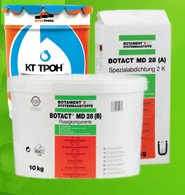
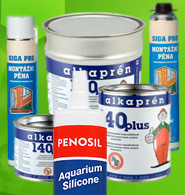
 Ukraine
Ukraine Kazakhstan
Kazakhstan Belorussia
Belorussia Moldova
Moldova Russia
Russia Uzbekistan
Uzbekistan Azerbaijan
Azerbaijan Armenia
Armenia Georgia
Georgia Kyrgyzstan
Kyrgyzstan Turkmenistan
Turkmenistan Tajikistan
Tajikistan Poland
Poland Hungary
Hungary Romania
Romania Bulgaria
Bulgaria Czech
Czech Slovenia
Slovenia Slovakia
Slovakia Serbia
Serbia Croatia
Croatia Montenegro
Montenegro Bosnia
Bosnia Estonia
Estonia Latvia
Latvia Lithuania
Lithuania